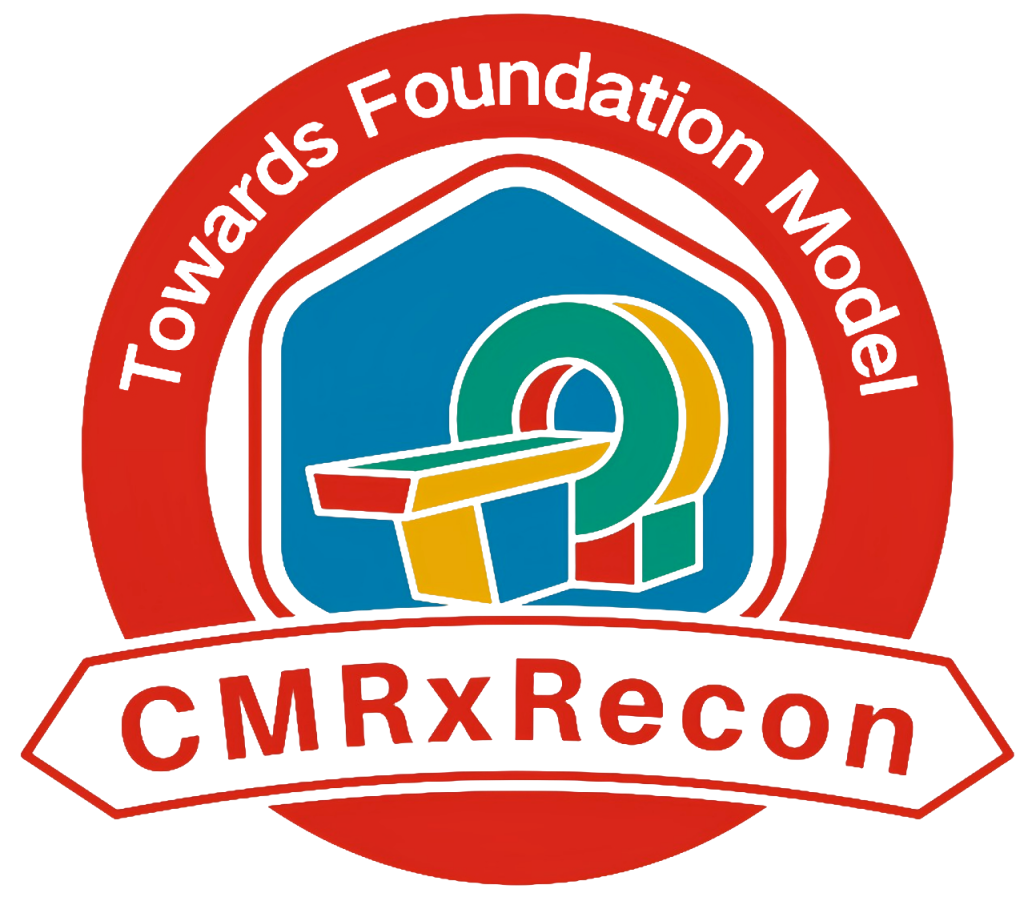1. Sign up and apply to join the challenge on the Synapse website.
2.
Submit your team information here.
Download data here.
Participants are expected to train models in their local computational environments and to submit docker containers on Synapse platform. A leaderboard will be maintained on the Synapse platform during the validation phase.
We provide the code to facilitate the use of the data we release
at https://github.com/CmrxRecon/CMRxRecon2025.
A
brief description of the provided package is as follows:
- CMRxReconDemo: contains parallel imaging
reconstruction code
- ChallengeDataFormat: explains the challenge data and
the rules for data submission
- CMRxReconMaskGeneration: contains code for varied
undersampling mask generation in different tasks
- Evaluation: contains image quality evaluation code for
validation and testing
- Submission: contains the structure for challenge
submission
Validation of the received docker on unseen test set will be
performed on a cloud server with a configuration as follows:
You are free to use and/or refer to the CMRxRecon2025 challenge and
datasets in your own research after the embargo period (Dec. 2025), provided that you cite the following
manuscripts:
Reference of the CMR imaging acquisition protocol:
1.Wang C, Lyu J, Wang S, et al. CMRxRecon: A publicly available k-space dataset and benchmark to advance
deep learning for cardiac MRI. Scientific Data, 2024, 11(1): 687.
2.Wang Z, Wang F, Qin C, et al. CMRxRecon2024: A Multimodality, Multiview k-Space Dataset Boosting Universal
Machine Learning for Accelerated Cardiac MRI, Radiology: Artificial Intelligence. 7(2): e240443, 2025. doi:
https://pubs.rsna.org/doi/10.1148/ryai.240443.
3.Lyu J, Qin C, Wang S, et al. The state-of-the-art in cardiac MRI reconstruction: Results of the CMRxRecon
challenge in MICCAI 2023. Medical Image Analysis. 101: 103485, 2025. doi:
https://doi.org/10.1016/j.media.2025.103485.
4.Wang C, Li Y, Lv J, et al. Recommendation for Cardiac Magnetic Resonance Imaging-Based Phenotypic Study:
Imaging Part. Phenomics. 2021, 1(4): 151-170.
5.Wang S, Qin C, Wang C, et al. The Extreme Cardiac MRI Analysis Challenge under Respiratory Motion
(CMRxMotion). arXiv preprint arXiv:2210.06385, 2022.
Reference for previously developed reconstruction
algorithms:
1.Wang C, Jang J, Neisius U, et al. Black blood myocardial T2 mapping. Magnetic resonance in medicine. 2019,
81(1): 153-166.
2.Lyu J, Wang S, Tian Y, Zou J, Dong S, Wang C, Aviles-Rivero AI, Qin J. STADNet: Spatial-Temporal
Attention-Guided Dual-Path Network for cardiac cine MRI super-resolution. Medical Image Analysis,
2024;94:103142.
3.Lyu J, Li G, Wang C, et al. Region-focused multi-view transformer-based generative adversarial network for
cardiac cine MRI reconstruction. Medical Image Analysis, 2023: 102760.
4.Lyu J, Tian Y, Cai Q, Wang C*, Qin J. Adaptive channel-modulated personalized federated learning for
magnetic resonance image reconstruction. Computers in Biology and Medicine, 2023, 165: 107330.
5.Qin C, Schlemper J, Caballero J, et al. Convolutional recurrent neural networks for dynamic MR image
reconstruction. IEEE transactions on medical imaging, 2018, 38(1): 280-290.
6.Qin C, Duan J, Hammernik K, et al. Complementary time-frequency domain networks for dynamic parallel MR
image reconstruction. Magnetic Resonance in Medicine, 2021, 86(6): 3274-3291.
7.Lyu J, Tian Y, Cai Q, et al. Adaptive channel-modulated personalized federated learning for magnetic
resonance image reconstruction. Computers in Biology and Medicine, 2023, 165: 107330.
8.Lyu J, Tong X, Wang C. Parallel Imaging With a Combination of SENSE and Generative Adversarial Networks
(GAN). Quantitative Imaging in Medicine and Surgery. 2020, 10(12): 2260-2273.
9.Lyu J, Sui B, Wang C, et al. DuDoCAF: Dual-Domain Cross-Attention Fusion with Recurrent Transformer for
Fast Multi-contrast MR Imaging. International Conference on Medical Image Computing and Computer-Assisted
Intervention. Springer, Cham, 2022: 474-484.
10.Ouyang C, Schlemper K, et al. Generalizing Deep Learning MRI Reconstruction across Different Domains,
arXiv preprint arXiv: 1902.10815, 2019.
11. Wang Z, Qian C, Guo D, Sun H, Li R, Zhao B, Qu X, One-dimensional Deep Low-rank and Sparse Network for
Accelerated MRI, IEEE Transactions on Medical Imaging, 42: 79-90, 2023.
https://doi.org/10.1109/TMI.2022.3203312
12. Wang Z, et al., Deep Separable Spatiotemporal Learning for Fast Dynamic Cardiac MRI, arXiv preprint
arXiv:2402.15939, 2024. https://arxiv.org/abs/2402.15939
created with
Website Builder Software .

